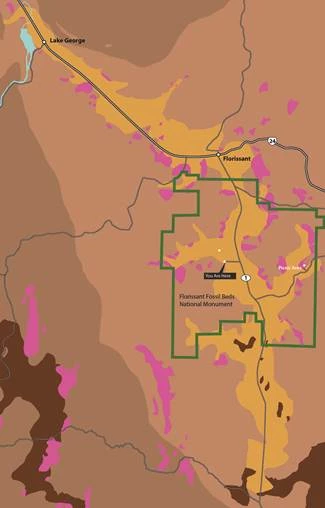|
Fossils Additional fossil photographs To learn more about the fossils found at the National Monument, you can download our Site Bulletins.Fossil PlantsClimate Change Did you know? Frequently Asked Questions about Paleontology There are two types of fossils that you will see on a visit to the Monument - massive petrified stumps of redwood tree and tiny, fragile fossils of insects, spiders, fish, leaves, cones, and seeds. The redwood stumps are the fossils you will see outside walking around. They are best seen in the outdoor exhibit area behind the visitor center and on the one-mile, self-guided, Petrified Forest Loop. The tiny, fragile fossils are best seen in displays in the visitor center.
Are there dinosaur fossils here?
There are no dinosaurs at the monument. The fossils from the Florissant fossil beds are from the late Eocene Epoch, approximately 34 million years ago, and the dinosaurs went extinct approximately 65 million years ago at the end of the Cretaceous Period.
Can I collect fossils in the Monument? Where can I collect fossils?
Collecting any natural or cultural feature is prohibited because this is a national park area. Fossils, rocks, flowers, pinecones, artifacts, etc. must remain in the Monument and be undisturbed. There is a small, privately owned quarry outside the Monument where you can pay a fee and collect fossils.
Are "they" still "digging" and looking for fossils?
Yes, we have a full-time paleontologist and on occasion excavations are conducted, however, other research projects are always taking place.
What was the climate like at Florissant during the Eocene?
Florissant was warmer during the Eocene than today. By studying the fossil plants, scientists have suggested that it was likely a warm temperate to subtropical environment with a distinct dry season during the winter.
To learn more about the climate, you can download our Climate Change Site Bulletin. How many petrified stumps are there? How do you find new stumps?
There are at least 30 known stumps, but it is possible that there are still undiscovered stumps beneath the ground. Scientists are not actively searching for new stumps. In fact, some of the stumps were buried in the late 1980's to protect them from weathering. Some techniques such as ground penetrating radar (GPR) have shown limited success in locating buried stumps.
When did Lake Florissant form and how large was it?
Lake Florissant formed during the late Eocene, 34 to 35 million years ago, and was approximately 1 mile wide and 12.5 miles long. Even though the lake no longer exists, the modern rock outcrops still show the extent of the lake (see the orange outcrop in the map below).

|
Last updated: June 21, 2022
